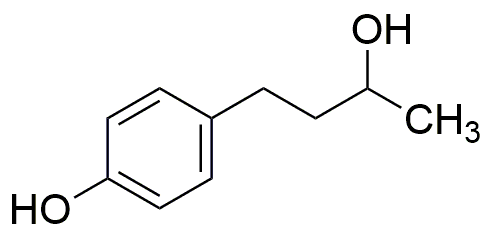Rhododendrol is widely utilized in research focused on:
- Cosmetic Formulations: This compound is often used in skincare products for its skin-lightening properties, making it popular in formulations aimed at reducing hyperpigmentation.
- Pharmaceutical Applications: Rhododendrol has potential therapeutic effects, particularly in dermatology, where it may be explored for treating skin disorders due to its anti-inflammatory properties.
- Research on Melanogenesis: It serves as a valuable tool in studies investigating the mechanisms of melanin production, helping researchers understand pigmentation processes and develop targeted treatments.
- Industrial Applications: The compound is also explored in the production of dyes and pigments, providing vibrant colors in various materials, including textiles and plastics.
- Antioxidant Research: Rhododendrol is being studied for its antioxidant capabilities, which could lead to applications in food preservation and health supplements aimed at combating oxidative stress.
Información general
Propiedades
Seguridad y normativas
Aplicaciones
Rhododendrol is widely utilized in research focused on:
- Cosmetic Formulations: This compound is often used in skincare products for its skin-lightening properties, making it popular in formulations aimed at reducing hyperpigmentation.
- Pharmaceutical Applications: Rhododendrol has potential therapeutic effects, particularly in dermatology, where it may be explored for treating skin disorders due to its anti-inflammatory properties.
- Research on Melanogenesis: It serves as a valuable tool in studies investigating the mechanisms of melanin production, helping researchers understand pigmentation processes and develop targeted treatments.
- Industrial Applications: The compound is also explored in the production of dyes and pigments, providing vibrant colors in various materials, including textiles and plastics.
- Antioxidant Research: Rhododendrol is being studied for its antioxidant capabilities, which could lead to applications in food preservation and health supplements aimed at combating oxidative stress.
Documentos
Hojas de datos de seguridad (HDS)
La SDS proporciona información de seguridad completa sobre la manipulación, el almacenamiento y la eliminación del producto.
Especificación del producto (PS)
La PS proporciona un desglose completo de las propiedades del producto, incluida la composición química, el estado físico, la pureza y los requisitos de almacenamiento. También detalla los rangos de calidad aceptables y las aplicaciones previstas del producto.
Certificados de análisis (COA)
Busque certificados de análisis (COA) ingresando el número de lote del producto. Los números de lote y de partida se pueden encontrar en la etiqueta de un producto después de las palabras "Lote" o "Lote".
Número de catálogo
Número de lote/lote
Certificados de origen (COO)
Este certificado de origen confirma el país en el que se fabricó el producto y también detalla los materiales y componentes utilizados en él y si se deriva de fuentes naturales, sintéticas u otras fuentes específicas. Este certificado puede ser necesario para cumplir con las normativas aduaneras, comerciales y regulatorias.
Número de catálogo
Número de lote/lote
Hojas de datos de seguridad (HDS)
La SDS proporciona información de seguridad completa sobre la manipulación, el almacenamiento y la eliminación del producto.
DownloadEspecificación del producto (PS)
La PS proporciona un desglose completo de las propiedades del producto, incluida la composición química, el estado físico, la pureza y los requisitos de almacenamiento. También detalla los rangos de calidad aceptables y las aplicaciones previstas del producto.
DownloadCertificados de análisis (COA)
Busque certificados de análisis (COA) ingresando el número de lote del producto. Los números de lote y de partida se pueden encontrar en la etiqueta de un producto después de las palabras "Lote" o "Lote".
Número de catálogo
Número de lote/lote
Certificados de origen (COO)
Este certificado de origen confirma el país en el que se fabricó el producto y también detalla los materiales y componentes utilizados en él y si se deriva de fuentes naturales, sintéticas u otras fuentes específicas. Este certificado puede ser necesario para cumplir con las normativas aduaneras, comerciales y regulatorias.


